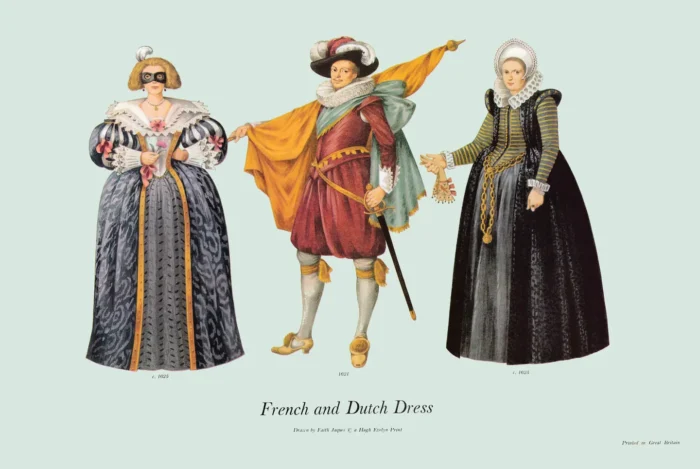French and Dutch Dress, 1621-1625
£15.00
French and Dutch Dress, 1611-1625 (scroll down for a more detailed Description)
Published 1968 by © Hugh Evelyn Limited; drawn by Faith Jaques
Size: c. 38 x 25.5 cm [15″ x 10″] may vary slightly from printers’ cut 50 years ago
Printed on medium cardstock weighing 151 g/sm2 faced in light greyish cyan – lime green (RGB: c. d8e8e0)
Print is STANDARD size – shipping is the same for 1 to 10 prints (based on largest print size in your order) – see Shipping & Returns.
In stock
Description
After Dutch independence, the importance of the burgher class, and the free-thinking religion of the people, created a democratic country different from other Europeans. The distinctive Netherlands costume was in every detail (except women’s caps) based on old Spanish fashion. The Spanish favoured black and sedate colours and these proud people made the old style a national dress as an outward sign of their achievement. The artistic record their great artists have left us show a cheerful people. The pursuit of righteousness was a gloomy preoccupation in England and the American dependencies but the Dutch took their religion more happily. Sharp angled skirts of the drum-farthingale never appealed to the Spanish who preferred rounded hips. The Spanish moderated the line by keeping the front flat but the Dutch, finding the long bodice fronts ideal for embroidery, exaggerated the awkward line so it stuck out like a shelf over the rounded skirt front. Extra emphasis was given by the front sections the bodice being finished by large tabs. The Dutch retained the overmantle which softened the outline of the figure from the neck to the hem of the gown. The waist rose, the stomacher persisted as a decoration, but no longer constricting, and the overmantle became an overdress, caught to the sides of the stomacher but open in front to show a contrasting underskirt. The silhouette changed from the rounded, drum shape to flat fronts with width at the sides, emphasized by full sleeves and wide spreading collars of the Medici shape worn at a different angle. The Dutch burgher women clung to their large ruffs until the 1640s. Supports for collars, in wire or bone and horsehair, were discarded and air could play round necks. A boom in lacemaking lasted a hundred years. Cuffs of lawn and lace took the place of small ruffs at the wrist. With the new widened trend in the general shape, hair was parted and frizzed out over the ears with small tendrils flattened to the forehead. The Dutch burgher women allowed their bonnets to widen at the sides. The men responded like a sunflower to the light and with the same blandness. He loosened his seams and fixed his jerkin and breeches in proportion to his figure. The waist was now in the natural place and full breeches that had hung down floppily now reached just to the knees. Long hose was tied in and to prevent sagging by large bows. Sleeveless leather jerkins became popular but often doublet sleeves were loose and only attached at the shoulders for greater freedom of movement. These details were functional. Although the clothes were loose and decorative, the proportion was natural and the appearance different from the flamboyance of the middle of the century. The biggest change was in the hat. Religious sects retained a high conical crown, but the soldier and man of fashion wore the shape that symbolized the elegance and humour of the period. The well-fed, smiling faces under the wide sweep of hat brims and feathers are more enlightening as to the character of the people than any lengthy social history.
Additional information
| Weight | 0.0147 kg |
|---|---|
| Dimensions | 38 × 25.5 cm |





